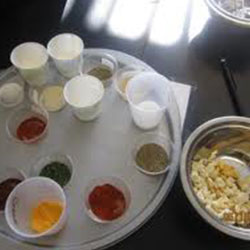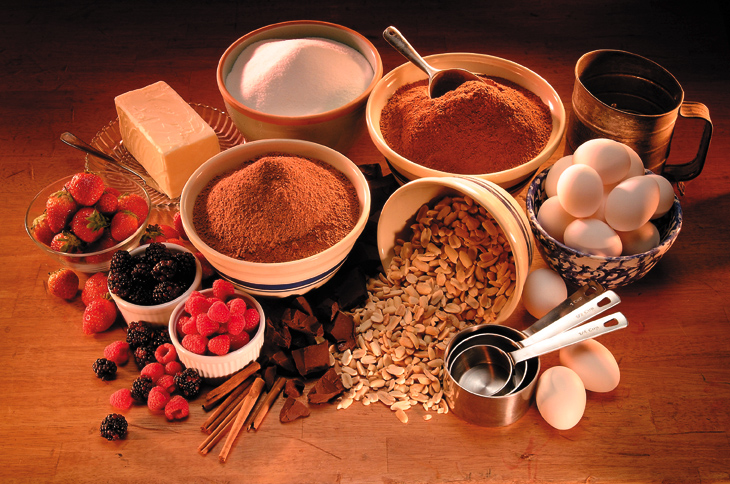FLAVORINGS
Flavor plays an important role in the consumption and acceptance of food and in the quality of life in general. The importance of flavour in food with regard to its palatability is well-known, but its value to digestion and metabolism must not be overlooked. The flavour and taste of food stimulate salivary flow and acid digestion.
Not only must food be palatable to be accepted in adequate amounts over a prolonged time, it must also be presented in sufficient variety to achieve a balanced and nutritionally adequate diet. These aspects are largely a function of flavor. Therefore flavorings are an essential constituent of human food.
The appreciation of flavor varies from region to region due partly to cultural and genetic differences and partly to the local availability of foods and food flavorings.
The increase in the world’s population and the movement of people from rural areas to towns resulted in life-style changes and the need for a more formalized food supply structure. This developed into the food industry.
Most of the daily food intake, even in industrialized countries, is freshly prepared and its flavor is either intrinsic or formed during cooking. However, in line with increasing demand for convenience, there is a growing range of industrially prepared foods. The addition of scientifically developed flavorings is needed to compensate for the loss of flavor during the processing of such foods.
Another result of urbanization and our modern way of life is the demand for snacks, soft drinks, desserts, confectionery and so on. This sort of food would be most uninteresting without the addition of flavorings.
Flavorings are highly concentrated mixtures of different ingredients combined together to recreate the desired flavor. The ingredients used may be grouped into the following categories:
Natural aromatic raw materials, such as natural fruit juices, spices and herbs
Natural flavor concentrates, such as natural citrus oils, spice extracts, fruit juice concentrates
Flavoring substances with a defined chemical structure and flavoring properties. These substances are further subdivided into three groups: natural substances, nature-identical substances and artificial substances
Flavorings are not to be compared to nor confused with food additives. Flavorings are self-limiting in use – they have such a strong impact on taste that they cannot be “over dosed” as this would make the food inedible.
The flavourist’s art of creating flavorings – combining different substances in a way that meets the demands of the food manufacturer and the consumer – requires tremendous expertise and skills. Without these flavorings many of our gastronomic pleasures would be greatly reduced.
PRODUCTS LIST
Almond
Amaretto
AniseedApple
Apple-cinnamon
Banana
Berries
Blackcurrant
Blueberry Muffin
Brandy
Butter
Butter Vanilla Paste
Butterscotch
Capsicum
Caramel
Cardamom
Cheese
Chilli
Chocolate
Cinnamon
Cinnamon-Clove
Citrus Peel
Cocoa
Chocolate Paste
Coconut Plain
Coconut Toasted
Coffee
Condensed Milk
Cranberry
Cappuccino
CustardDanish Butter
Banana
Berries
Blackcurrant
Bubble gum Wicky Wax
Butter
Butterscotch
Caramel
Cherry
Chocolate
Citrus
Coconut
Cocopine
Coffee
Cola
Cream
Cream Soda
Condensed Milk
Cappuccino
Custard
English Toffee
Fruits of the Forest
Fudge
Fig Jam
Fruits of the Forest
FudgeGinger
Hazelnut
Hazelnut paste
Honey
Jasmine
Lemon
Lemon-Lime
Maple
Mint
Mushroom truffle
Noce Paste
Olive Oil
Orange
Peanut Butter
Peanut Butter Paste
Pistachio
Rose
Short Bread
Strawberry
Sweetcorn
Tiramisu Paste
Toffee
Vanilla
Winter Ginger Spice
Yoghurt
Almond
AppleApple-cinnamon
Apricot
Ginger
Granadilla
Grape
Grenadine
Hazelnut
Honey
Honey-Melon
Jasmine
Kahlua
Kiwi
Lavender
Lemon
Lemon-Lime
Lime
Liquorice
Lychee
Maple
Mint
Melon
Orange
Raspberry
Rose
MORE :
monosodium glutamate
glycine
L-alanine
disodium succinate
Disodium 5'-ribonucleotides
Ethyl maltol



More about Flavourings :
The acceptability of any food product greatly depends on the impression of taste when it is eaten. Our sense of taste is really a combination of two of our senses, taste and smell . Both of these sense respond to certain chemicals.
How do we taste?
Taste is a complex mixture of flavours and aroma, or smell.
The receptors for the human sense of taste are located on the tongue and on the soft palate. There are just five stimuli to which these receptors respond. These are:
sweet (as in sugar)
sour (as in acidic substances like lemon juice)
bitter (strong coffee or quinine in tonic water)
salt (table salt)
umami (monosodium glutamate, savouries, soya sauce, crisps)
The traditional view is that tastes are detected on different parts of the tongue . Receptors for each taste are located in taste buds in specific areas of the tongue and each area can only detect one particular taste.
However, more recent research suggests that this may not be the case. The taste buds are still found in the same areas on the tongue but each one can detect all five tastes (sweet, sour, bitter, salt and umami). The brain is able to recognize which receptors are being stimulated and this goes towards the flavor sensation that we experience. The way in which we taste foods and perceive flavors is clearly very complex.
Our sense of smell also makes up a big part of how well we ‘taste’ food. Flavor molecules in the food enter the air in the nose and are detected by millions of receptors that feed information to the brain. Chewing helps to transfer more odor from the mouth to the back of the nose. The area which is sensitive to smell is located at the back of the nose where several million receptor cells per square centimeter respond to thousands of chemicals in the food.
Sight plays an unexpectedly important role in our perception of flavors. The taste of a colourless, shapeless food is extremely difficult to recognize. We may need visual “clues” to enable us to identify taste and flavour accurately.
The brain interprets signals from taste, smell and even vision before turning them into an impression of the food’s taste. Different people will find different. Flavourings are added to food products to give, enhance or intensify flavour tastes nice or unpleasant.


COCOA PRODUCTS
An aroma compound, also known as odorant, aroma, fragrance, or flavor, is a chemical compound that has a smell or odor. A chemical compound has a smell or odor when it is sufficiently volatile to be transported to the olfactory system in the upper part of the nose.
Generally molecules meeting this specification have molecular weights of <300. Flavors affect both the sense of taste and smell, whereas fragrances affect only smell. Flavors tend to be naturally occurring, and fragrances tend to be synthetic.
Aroma compounds can be found in food, wine, spices, perfumes, fragrance oils, and essential oils. For example, many form biochemically during ripening of fruits and other crops. In wines, most form as byproducts of fermentation. Also, many of the aroma compounds play a significant role in the production of flavorants, which are used in the food service industry to flavor, improve, and generally increase the appeal of their products.
An odorizer may add an odorant to a dangerous odorless substance, like propane, natural gas, or hydrogen, as a warning.






